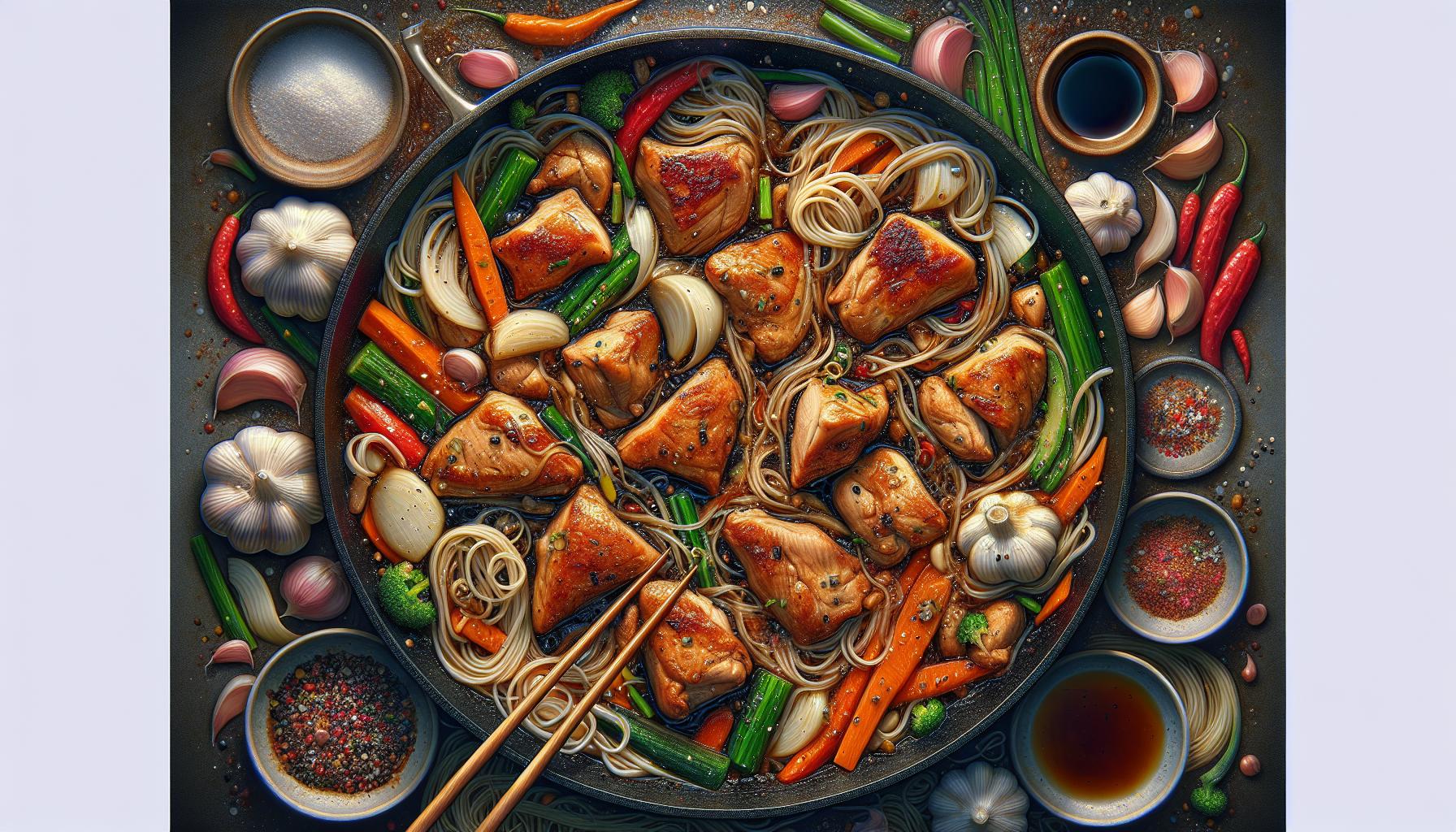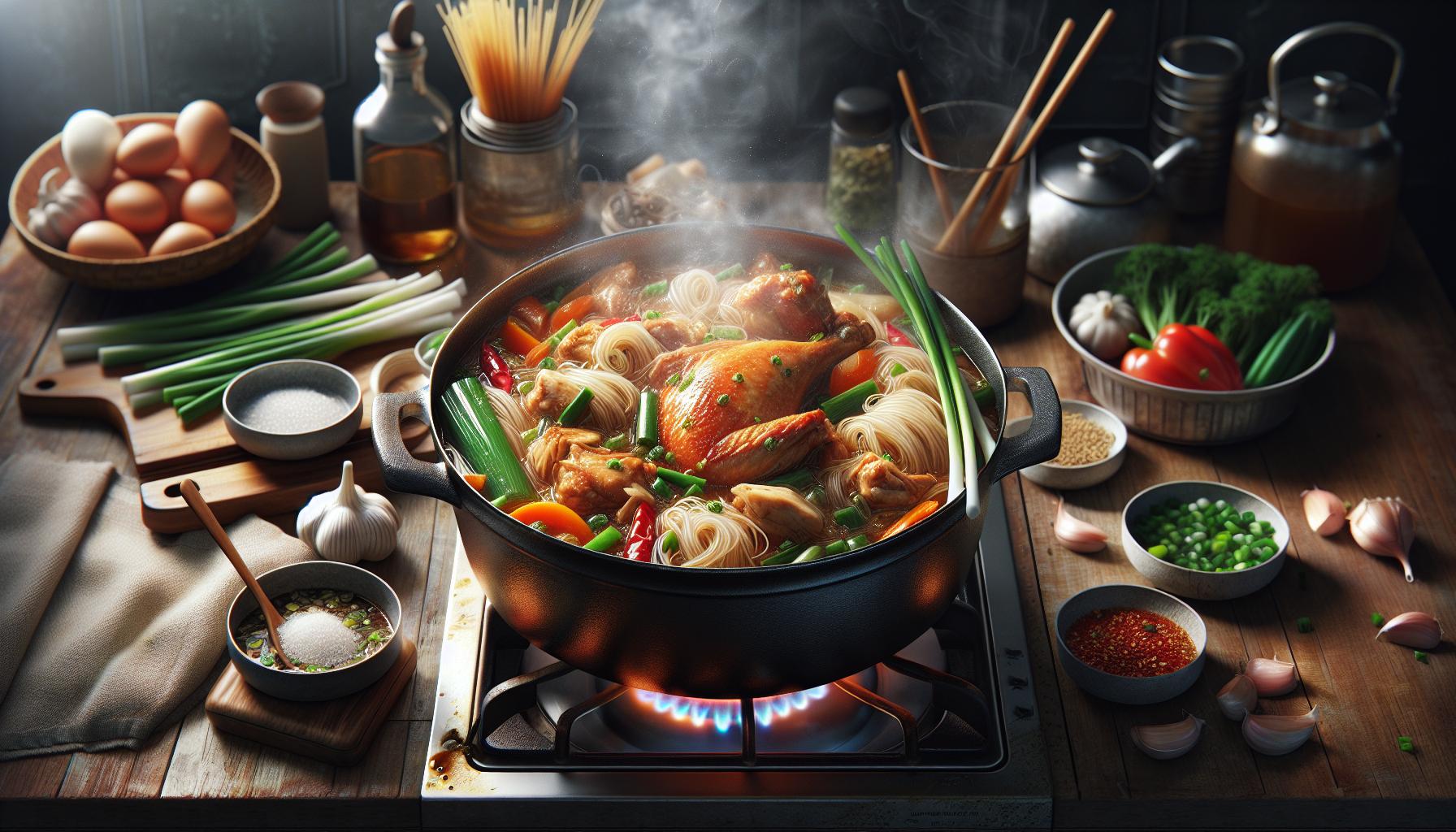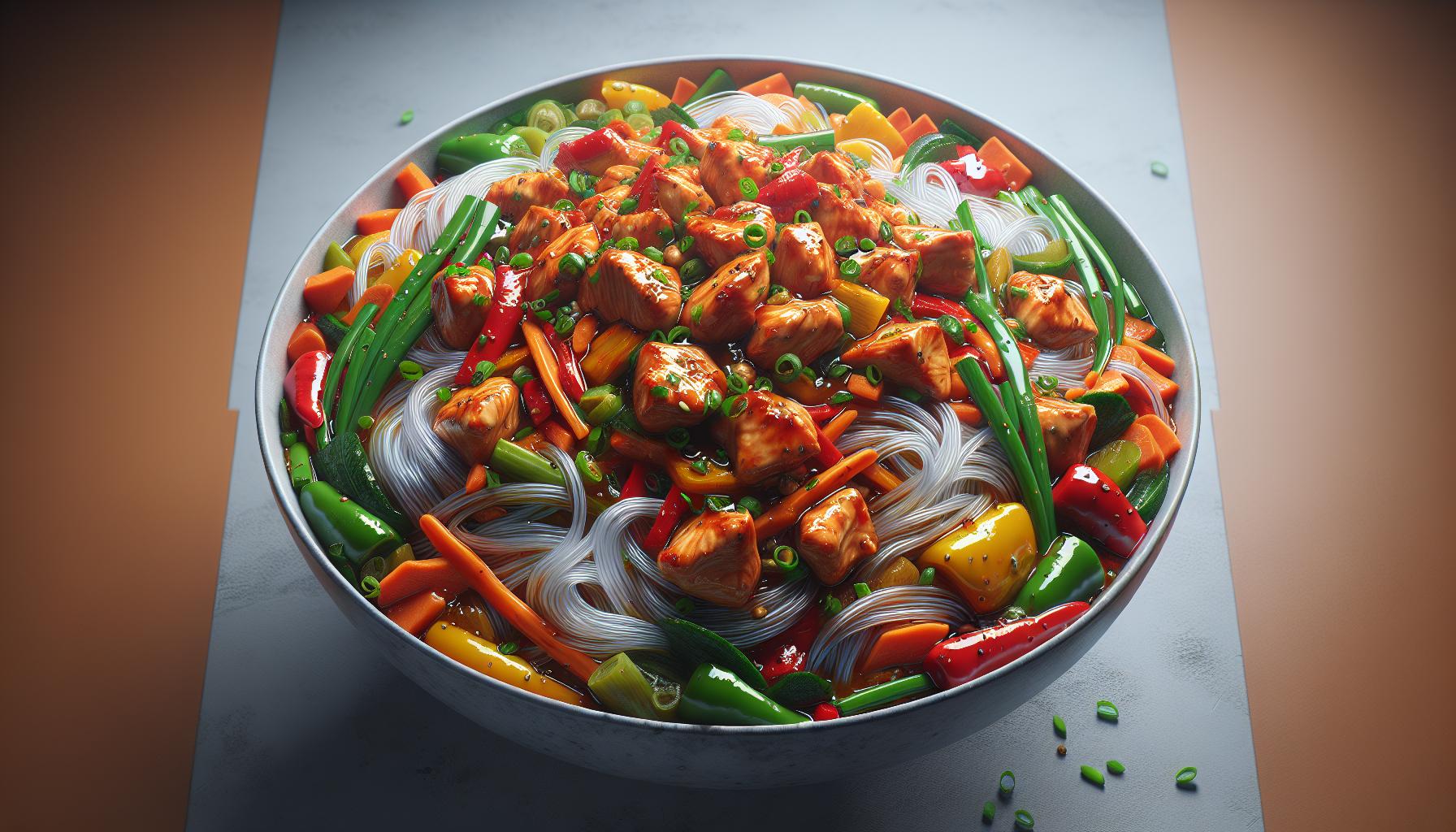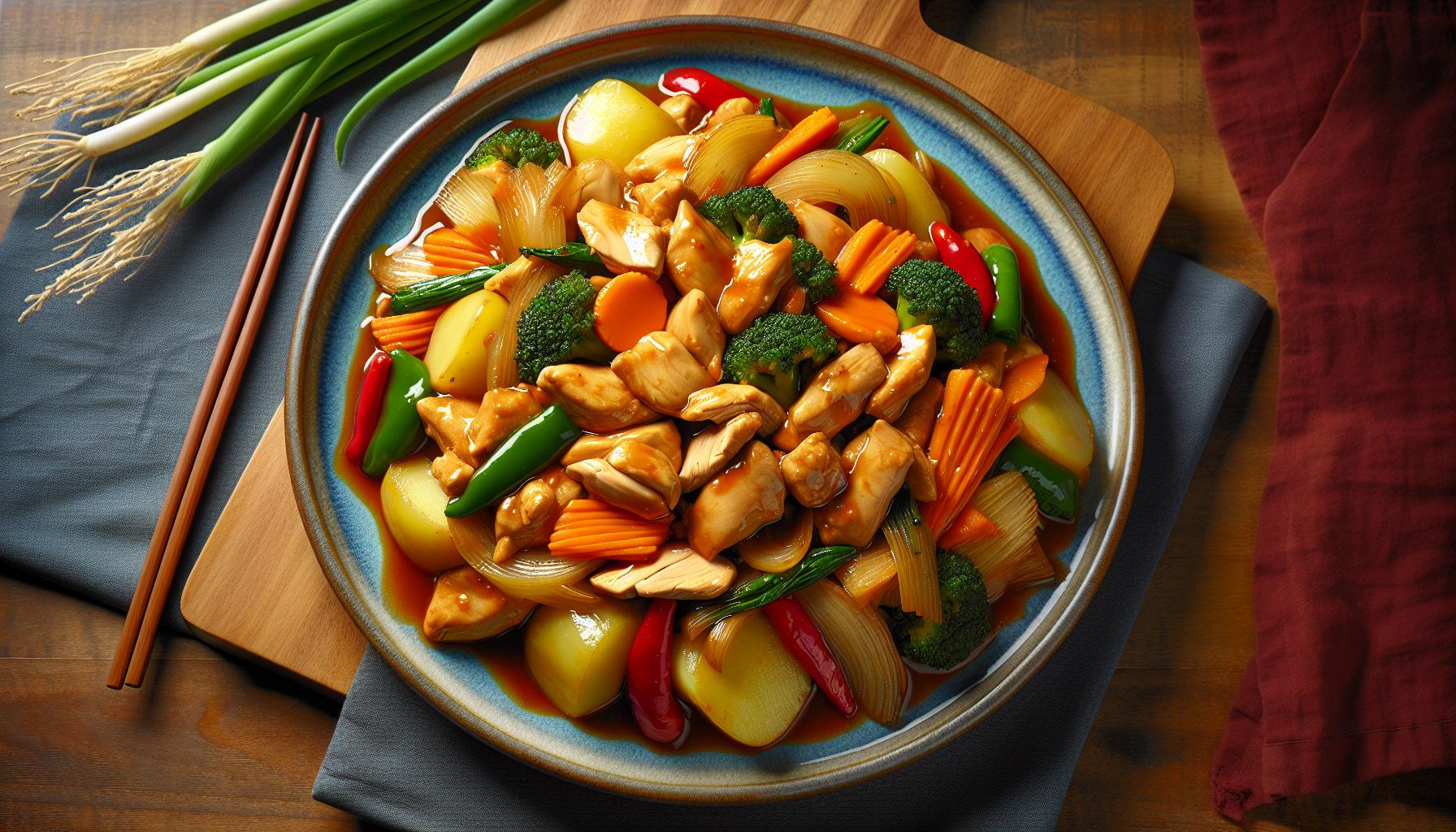Ingredients for Homemade Jjimdakdakjjim
Delve deeper into the heart of Korean cuisine. Get your apron on. It’s time for the homemade Jjimdakdakjjim recipe. Below are the ingredients you’ll require for this must-try Korean dish.
- Chicken, 1.5 lbs, pieces
- Whole garlic cloves, 10
- Potato starch noodles, 100 g
- Potatoes, 2-3 medium size
- Soy sauce, 1/2 cup
- Corn syrup, 1/4 cup
- Sugar, 2 Tbsp
- Ginger, 1 Tbsp, minced
- Black pepper, 1/2 tsp
- Water, 1 cup
- Carrots and onions, Large dices
Here’s a quick tip for you. Add more vegetables to your liking for a heartier dish. Don’t be afraid to experiment with slightly unusual ones such as beetroot or parsnip. Personalizing the dish to your taste can give it the extra kick you’re looking for.
Onto the nutritional aspects, Jjimdakdakjjim is no slacker. It’s low in saturated fat, high in protein, and has a balanced distribution of carbs and fiber thanks to the assortment of vegetables and starch.
Here’s a breakdown to help you keep track:
| Ingredients | Calories | Protein | Carbs | Fat |
|---|---|---|---|---|
| Chicken | 335 | 25g | 0g | 25g |
| Vegetables | 60 | 2g | 14g | 0g |
| Noodles | 491 | 0g | 121g | 1g |
You’ll realize that cooking Jjimdakdakjjim is not only an adventure but a journey towards a healthier lifestyle.
Prep your kitchen. Let’s take the next step and start cooking.
Step-by-Step Cooking Instructions

To craft your very own homemade Jjimdakdakjjim, you’ll follow a series of simple steps. Once you’ve got your ingredients assembled – remember to consider adding unique vegetables like beetroot or parsnip for your own twist – it’s time to dive into the cooking process.
To begin, cut your chicken into chunks and soak in cold water for about 20-30 minutes. This might seem unusual but it helps to eliminate any unpleasant smells from the chicken. While this is happening, soak your glass noodles – or dangmyeon – in warm water.
After draining the chicken, it’s time to place it into a large pot. On a medium-high heat, cook the chicken until it turns golden brown. Don’t worry if it’s not fully cooked at this stage – we’re just searing it for enhanced flavor.
With your chicken browned, add soy sauce, garlic, pepper, sugar, and water. Stir well and bring the mix to a boil. Once it’s boiling, reduce the heat to low, cover the pot and let it simmer for about 20 minutes.
At this point, you can add your veggies – carrots, potatoes, and onions first, as these will take longer to cook. When the potatoes are halfway done, add the mushrooms and those unique veggies you’ve chosen.
Now it’s time to add your pre-soaked glass noodles to the pot. Make sure all the ingredients are mixed together well and cook for another 10-15 minutes. You’ll want the sauce to thicken and the noodles to soften.
The last step in cooking involves the addition of a few final ingredients. Toss in green onions and sesame seeds for added flavor. Adjust the seasoning if needed – and there you have it!
Tips for Perfecting the Korean-Style Braised Dish

Attention to the chicken is your key secret. Opt for bone-in chicken parts like thighs or drumsticks. Bone-in pieces infuse the broth with a hearty depth of flavor that boneless cuts just can’t muster.
The soaking step might seem a little redundant. Trust me, it’s not. Cold water removes any off-putting scent, rendering your chicken fresher, cleaner. It’s a subtle difference but one your guests will undoubtedly notice.
Discover the charm in soy sauce. Not all soy sauces are created equal. Some add a sweet touch, others a hint of smoke. Find one that complements the distinctive flavors you’re chasing.
Don’t shy away from garlic. Garlic is a staple in Korean cuisine, imparting its unique, bold flavor. But getting that smooth, mellow sweetness? That comes from proper browning. Gentle, low heat is your ally here. Remember: garlic burns quickly.
Fiddle with your veggies. Carrots, potatoes, even beetroot or parsnip. Switch them up. Find what sings to your taste buds. Don’t be afraid to walk off the beaten path.
Glass noodles? A must. They add that signature chewiness, soaking up all the succulent juices. Make sure to pre-soak them before they join the pot. Here’s a tip: the colder the water, the firmer your noodle texture.
The simmer. That’s where the magic happens. The flavors meld, the sauce thickens. A low, slow simmer weaves everything together beautifully.
End with green onions, sesame seeds. A pop of color, a kiss of crunch. You’ve know your Jjimdakdakjjim is ready when the aroma calls out, invites you to dig in.
Nutritional Attributes
Let’s not forget those nutritional bits:
| Nutrition | Value |
|---|---|
| Calorie | Approximately 500 per serving |
| Carbs | Around 35g |
| Protein | About 60g |
| Fat | Roughly 10g |
Remember, each serving isn’t just delicious, it’s packed with valuable proteins, crucial carbs, and beneficial fats.
Serving and Presentation Ideas

With your JJimdakdakjjim ready and the enticing aroma filling your kitchen, it’s time to discuss the best ways to serve and present this Korean delicacy.
Keep in mind, the first look at your dish is as important as its flavor. It’s absolutely vital to strike a balance between visual appeal and hearty nourishment. Serving it the right way, can spell the difference between a satisfactory meal and a truly memorable dining experience.
One classic way to serve your JJimdakdakjjim is in a large bowl. Having all parts of the dish visible at once puts the colorful vegetables and shiny, savory chicken on full display. You can place the glass noodles on the bottom of the bowl, covered with chicken pieces, and then generously drizzle the thick, flavorful sauce over the heap. It’s an instant feast to eyes!
Health Benefits of Homemade Jjimdakdakjjim

Diving into the health benefits of homemade Jjimdakdakjjim, you’ll find it’s more than just a flavorful feast. Nutritionally dense, this dish keeps you full, fuels your body, and provides a wealth of essential vitamins and minerals.
First off, let’s talk about the protein-packed chicken. It’s an excellent source of lean protein, supporting muscle growth and maintenance. Plus, it’s lower in saturated fat compared to many other meat types.
As for the vegetables, they are the stars of this dish when it comes to micronutrients. With the colorful array of carrots, potatoes, bell peppers, and onions, you’re not only livening up the plate but also pumping your body with plenty of vitamins, fiber, and antioxidants which aids in digestion, immune function, and overall health.
The sauce is a powerhouse combo. Soy sauce, supplying a modest amount of Vitamin K and B-3, garlic with notable amounts of Vitamin C and B-6, along with ginger providing anti-inflammatory and digestive perks.
Take a look at the complete nutritional breakdown:
| Ingredients | Protein (g) | Fiber (g) | Vitamins and Minerals |
|---|---|---|---|
| Chicken | 25 | 0 | Thiamine, Vitamin B6 |
| Vegetables | 2-3 | 3-4 | A, C, K, Potassium |
| Sauce | 1 | 0 | K, B-3, C, B-6 |
To add an extra nutrition boost, opt for brown rice or whole grain noodles as a base. These are high in fiber, promoting digestion, and helping to maintain a healthy weight.
The beauty of homemade Jjimdakdakjjim is you can tweak the ingredients according to your preference or dietary needs. Need to limit sodium? Dial back on soy sauce. Looking for more vitamins? Load up the veggies. Making this dish at home gives you the reins to create a nutritionally balanced, delectable Korean feast. The choices are endless, and the benefits, undeniable.
Conclusion
So, you’ve discovered the ins and outs of homemade Jjimdakdakjjim. It’s not just a tasty dish, it’s a powerhouse of nutrition. With its high protein chicken and nutrient-rich veggies, this Korean style braised recipe is a feast for your body. The sauce, brimming with health-boosting ingredients like soy sauce, garlic, and ginger, adds to the nutritional punch. Remember, you can always amp up the fiber content with brown rice or whole grain noodles. Plus, the beauty of homemade Jjimdakdakjjim is the freedom to tweak the ingredients to your liking. It’s a delicious, customizable meal that’s as good for your health as it is for your taste buds.

